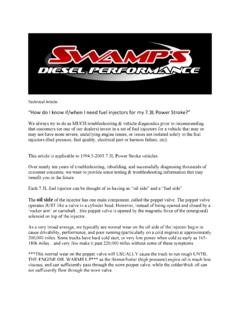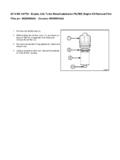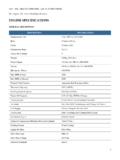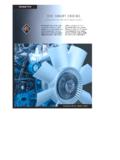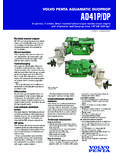Transcription of “How!do!I!know!if/when!Ineedfuelinjectorsformy7.3LPower ...
1 Technical Article: How do I know if/when I need fuel injectors for my Power Stroke? We always try to do as MUCH troubleshooting & vehicle diagnostics prior to recommending that customers (or one of our dealers) invest in a set of fuel injectors for a vehicle that may or may not have more severe, underlying engine issues, or issues not isolated solely to the fuel injectors (fuel pressure, fuel quality, electrical part or harness failure, etc). This article is applicable to Power Stroke vehicles. Over nearly ten years of troubleshooting, rebuilding, and successfully diagnosing thousands of customer concerns, we want to provide some testing & troubleshooting information that may benefit you in the future. Each fuel injector can be thought of as having an oil side and a fuel side.
2 The oil side of the injector has one main component, called the poppet valve. The poppet valve operates JUST like a valve in a cylinder head. However, instead of being opened and closed by a rocker arm or poppet valve is opened by the magnetic force of the (energized) solenoid on top of the injector. As a very broad average, we typically see normal wear on the oil side of the injector begin to cause drivability, performance, and poor running (particularly on a cold engine ) at approximately 200,000 miles. Some trucks have hard cold start, or very low power when cold as early as 165-180k very few make it past 220,000 miles without some of these symptoms. **This normal wear on the poppet valve will USUALLY cause the truck to run rough UNTIL THE engine OIL WARMS UP** as the thinner/hotter (high pressure) engine oil is much less viscous, and can sufficiently pass through the worn poppet the colder/thick oil can not sufficiently flow through the worn valve.
3 Many customers & shops misdiagnose this as not being associated with the fuel the truck may drive perfectly fine once the oil temp comes up. Other oil side symptoms can be excessive (white/grey) smoke on a cold start. As the poppet valve is wearing, it moves further and further away from the injector solenoid. This increased gap between these components is similar to retarding the injection fires late , so there is less time for the injected fuel to be fully combusted, creating excess smoke out the tailpipe. Other symptoms related to wear at this poppet valve may include, reduced ICP pressure (high pressure oil pressure), when the truck is up to temperature. As the valve wears, and cannot seal high pressure engine oil, which should be contained within this valve, is able to escape/leak around the valve, and be returned to the oil pan.
4 If the vehicle has reduced power, especially with more than 50-70% throttle ..there is a high probability that the cause of the reduced power is that the higher (commanded) pressure is increasing the volume of HPOil being lost at the worn injectors. If the vehicle will start, and run cold , but dies, or will not restart hot is also an indication that there may be substantial leaking at the injectors, preventing the thinner (hot) oil from producing the minimum required pressure to keep the vehicle running or start it when hot . The fuel side of the fuel injector contains many more components, which are not normally considered wear items. With proper fuel filtration, good, clean diesel fuel, and adequate fuel pressure, the fuel side of the injector can go well in excess of 400,000 miles without issue. However, ONE bad tank of diesel fuel (water, gasoline, poor filtration, etc) can immediately and permanently damage the fuel side.
5 Particularly, the plunger & barrel assembly, which relies on the diesel fuel to lubricate these very tight tolerance components. (Think of a piston in a cylinder piston a gap of only ) Since the injector is fired by high pressure engine lack of lubrication inside the plunger and barrel will almost instantly cause metal transfer between these two components (galling). Once/if the fuel side of the injector is damaged, the symptoms are usually much more consistent. As a plunger and barrel assembly is may be so severely galled, that any fuel that is trying to be pushed out of the nozzle, simply escapes up/past the is not injected at all. Any time a truck has a dead miss ..hot or cold, part throttle, or full throttle this is almost certainly a problem with the fuel side of the injector. A slightly damaged P&B assembly can, occasionally cause a rough running when the thinner/hotter diesel fuel is thin enough to escape up past the scored/galled plunger & barrel assembly.
6 Other considerations should be made when inspecting the vehicle as a Ford OEM airbox/filter lid design is less than reliable (look for broken clips, missing plastic tabs, holes in the rubber tubing between the turbo & air filter)..if any of these components are missing or broken, the customer should have SERIOUS concern regarding the air filter/air box, and the effects of dirty air entering the turbo and engine cylinders. (A new turbo on a rough running engine should make everyone question if the turbo was damaged by poorly filtered air< which may also have severely damaged the piston rings/cylinder walls) If the truck has a history of oil consumption, has any excessive crankcase pressure, &/or a new turbo , then it is our recommendation to perform a COMPRESSION TEST on the engine prior to purchasing, or recommending fuel injectors as the solution.
7 If a compression test isn t feasible, then all you can do is inspect the rest of the vehicle (worn turbo compressor wheel, white smoke out the tailpipe AT full operating temperature during an extended period of idle, lots of oil inside the air inlet tube<from air filter to turbocharger, check the blowby out of the oil fill cap<while blocking off the breather on the passenger side valve cover) for signs other signs that the engine (cylinders/rings/compression) may be too poor to significantly improve performance (or alleviate the customers rough running concerns) by installing a fresh set of injectors. The above tests and inspections are often going to give you much more information than ANY professional grade scan tool on the market can give. Common Diagnostic tests, related to the fuel injectors/ engine , that can be performed with a good scan tool are cylinder contribution test (CCT), and an injector buzz test.
8 Some tools can also monitor rotational velocity percentages. Cylinder contribution tests (CCT) & rotational velocity tests are not "injector" specific tests. A buzz test is as close to an injector specific injector buzz test, merely checks the electrical continuity to/from each inj to the IDM. all 8 injs 'buzz'..then that merely means that they are plugged in. No determination can be made about whether the injectors are good or somewhere in-between. The consistency (in tone) of the buzz test (audibly) should be considered and paid attention to when a buzz test is performed ..since any difference in sound can indicate problems (or just normal wear issues) related to the movement of the poppet valve, when it is pulled up by the (energized) solenoid. While any injector can immediately and permanently be damaged by lack of fuel pressure, fuel contamination, gas, water, the poppet valve in the injs is really the only part of the injector that 'wears'.
9 This valve operates just like a valve in a cyl this valve & seat wear allows the poppet to move further and further from the injector solenoid. This causes a couple of typical symptoms/issues. The larger the 'gap' between the solenoid and larger the delay in injector firing SIGNAL from the IDM is still getting to the solenoid at the 'speed of light'..but the mechanical wear (at the poppet valve) can cause the injector to open later than the electrical/commanded 'timing' might (think of this as turning the distributor on a gas engine the wrong way, LOL)..retarding the timing can cause lack of fuel efficiency, lack of power, and increased smoke at the tailpipe.< injector fires 'late'..the injected fuel isn't completely some % of that fuel makes its' way out the exhaust valve and into the tailpipe, Another function of normal poppet valve wear is poor valve sealing at the with cold (thick) engine damaged (poor sealing) valves can't allow the normal or proper amount of HPOil to enter the <<this cold oil/hot oil usually manifests itself as low power when cold, runs good very hard/no starts when usually plugging the block heater in (overnight) can warm the oil up enough to minimize these types of once the oil warms up (block heater or 10-15min of driving) can thin the oil out enough for a larger volume of oil to get through the (worn)
10 Poppet FWIW- the poppet valve is probably the area of the injector least understood by 99% of injector rebuilders out saying we know it we are confident enough to warranty ALL of our injs for 5yr/200k CCT test: this test compares the RELATIVE BALANCE between the output of (not just the injs!) but everything that contributes to the power output of that includes quite a from that cylinders compression (piston ring sealing), the intake & exhaust valve sealing, valve lift, injector output, 've even seen bad torque converters and flywheels cause enough engine vibration to cause various cylinder balance , while a scan tool can aid in the detection/direction of a experience can & will outweigh a scan tool 9 out of 10 "no codes" doesn't mean everything is "OK"..and because you HAVE a 't mean that there is a it has anything at all to do with a specific problem or issue.
